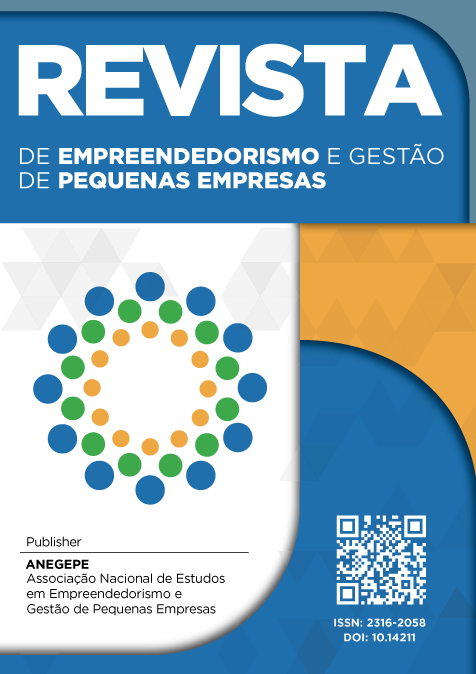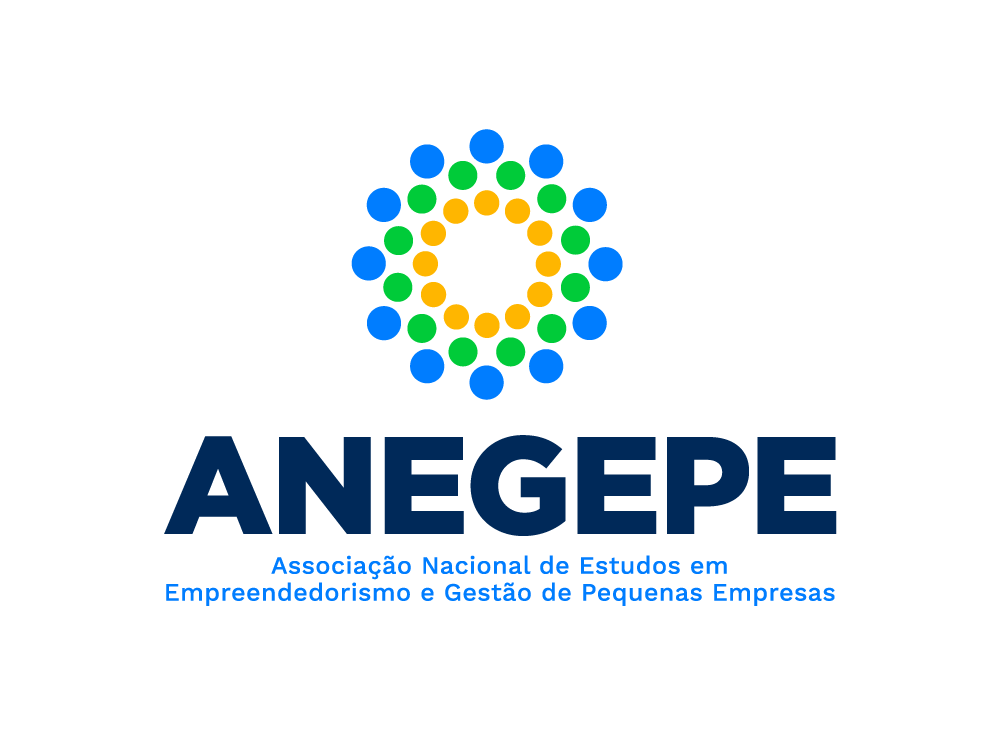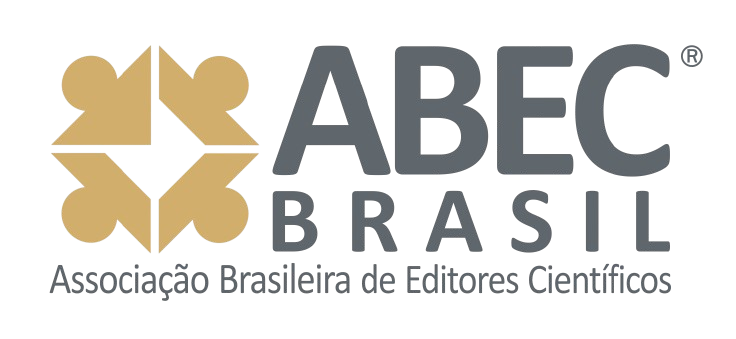Mineração de Patentes e Pequenas Empresas: Uma Revisão Sistemática da Literatura Sobre Oportunidades de Negócio Sob a Ótica da Inovação Aberta
DOI:
10.14211/regepe.v7i2.670Keywords:
Mineração de Patentes, Patent2Net, Pequenas Empresas, Inovação Aberta, EstratégiaAbstract
Este artigo destaca a mineração de patentes como meio para identificar oportunidades de negócio voltadas às pequenas empresas, valorizando em particular, a ferramenta computacional Patent2Net. Após uma revisão sistemática da literatura sobre as interrelações entre estes temas, concluiu-se que a mineração de patentes pode representar oportunidades efetivas tanto no âmbito da pesquisa e desenvolvimento, como na aplicação comercial. Sob a ótica da Teoria da Inovação Aberta, é possível que as pequenas empresas usem ferramentas de mineração de patentes para: 1) levantar recursos, 2) estabelecer parcerias com universidades, outras empresas e instituições de pesquisa; e 3) aperfeiçoar tecnologias e produtos existentes a partir do desenvolvimento de novas invenções e do registro formal das mesmas. O artigo busca também abrir portas para o diálogo sobre o treinamento na utilização das ferramentas para mineração de patentes como facilitador na busca do desenvolvimento tecnológico compartilhado.
Downloads
References
Abbas, A., Zhang, L., & Khan, S. U. (2014). A literature review on the state-of-the-art in patent analysis. World Patent Information, 37, 3–13. DOI: https://doi.org/10.1016/j.wpi.2013.12.006
Agostini, L., Caviggioli, F., Filippini, R., & Nosella, A. (2015). Does patenting influence SME sales performance? A quantity and quality analysis of patents in Northern Italy. European Journal of Innovation Management, 18(2), 238–257. DOI: https://doi.org/10.1108/EJIM-07-2013-0071
Audretsch, D. B. (2002). The Dynamic Role of Small Firms: Evidence from the U.S. Small Business Economics, 18(1–3), 13–40. DOI: https://doi.org/10.1023/A:1015105222884
Balasubramanian, N., & Sivadasan, J. (2011). What happens when firms patent? New evidence from US economic census data. The Review of Economics and Statistics, 93(1), 126–146. DOI: https://doi.org/10.1162/REST_a_00058
Bebczuk, R. N. (2010). Acceso al Financiamiento de las PYMES en Argentina: Estado de Situación y Propuestas de Política. Recuperado de http://cedlas.econo.unlp.edu.ar/archivos_upload/doc_cedlas104.pdf
Bessant, J., Lamming, R., Noke, H., & Phillips, W. (2005). Managing innovation beyond the steady state. Technovation, 25(12), 1366–1376. DOI: https://doi.org/10.1016/j.technovation.2005.04.007
Boyle, J. (2004). A Manifesto on WIPO and the Future of Intellectual Property. Duke L. & Tech. Rev., 2004, 9–15.
Brandenburger, A. M., & Nalebuff, B. J. (2011). Co-opetition. Crown Business. Recuperado de https://books.google.com.br/books?hl=pt-BR&lr=&id=sU2e-piQ3tUC&oi=fnd&pg=PA3&dq=co-opetition&ots=ObI-9IJMuf&sig=9jaDv-tS2NbsZigkwNNq2Yql4RQ
Brewster, R. (2011). Surprising Benefits to Developing Countries of Linking International Trade and Intellectual Property, The. Chi. J. Int’l L., 12, 1.
Cameron, G. (1996). Innovation and Economic Growth (CEP Discussion Paper No. dp0277). Centre for Economic Performance, LSE. Recuperado de https://ideas.repec.org/p/cep/cepdps/dp0277.html
Careil, J.-M. (2004). Système IN℡LIXIR. In Coupling approaches, coupling media and coupling languages for information retrieval (p. 930–930). Le centre de hautes etudes internationales d'informatique documentaire.
Carvalho, A. C., Storopoli, J. H., & Quoniam, L. (2014). Prospecção de Patentes para a Solução Sustentável de Problema da Indústria da Construção: O Espaçador de Concreto. Revista Inovação, Projetos e Tecnologias, 2(1), 115–127. DOI: https://doi.org/10.5585/iptec.v2i1.21
Chai, S., & Shih, W. (2016). Bridging science and technology through academic-industry partnerships. Research Policy, 45(1), 148–158. DOI: https://doi.org/10.1016/j.respol.2015.07.007
Chesbrough, H. W. (2003). The era of open innovation. MIT Sloan Management Review, Spring, 44(3), 35–41. DOI: https://doi.org/10.1177/000812560304500301
Chong, W. Y. (2012). Critical success factors for small and medium enterprises: perceptions of entrepreneurs in urban Malaysia. Journal of Business and Policy Research, 7(4), 204–215.
de Moraes, M. B., de Oliveira Lima, E., & Lobosco, A. (2011). Competências para inovar em pequenas e médias empresas tecnológicas. RAI-Revista de Administração e Inovação, 8(4), 206–226.
de Souza, J. R. M., & Silva, C. E. (2011). Metodologias de estímulo à criatividade e inovação no desenvolvimento de empreendedores: uma revisão teórica. Revista Brasileira de Administração Científica, 2(1), 68–86. DOI: https://doi.org/10.6008/ESS2179-684X.2011.001.0004
Durand-Barthez, M. (2013). Former à l’information Brevets dans l’enseignement supérieur. Revue internationale d’intelligence économique, 5(1), 25–38. DOI: https://doi.org/10.3166/r2ie.5.25-38
Eppinger, E., & Vladova, G. (2013). Intellectual property management practices at small and medium-sized enterprises. International Journal of Technology Management, 61(1), 64–81. DOI: https://doi.org/10.1504/IJTM.2013.050244
Ferraz, R. R. N., Quoniam, L., Reymond, D., & Maccari, E. A. (2016). Example of open-source OPS (Open Patent Services) for patent education and information using the computational tool Patent2Net. World Patent Information, 46, 21–31. DOI: https://doi.org/10.1016/j.wpi.2016.05.002
Gennari, U. (2013). IPR training and tools for better handling of IPR topics by SMEs. World Patent Information, 35(3), 214–223. DOI: https://doi.org/10.1016/j.wpi.2013.04.002
Gil, A. C. (1999). Métodos de pesquisa social (1a.). São Paulo: Atlas.
Globerman, S., Kokko, A., & Sjöholm, F. (2000). International technology diffusion: evidence from Swedish patent data. Kyklos, 53(1), 17–38. DOI: https://doi.org/10.1111/1467-6435.00107
Gnyawali, D. R., & Park, B.-J. (2009). Co-opetition and technological innovation in small and medium-sized enterprises: A multilevel conceptual model. Journal of Small Business Management, 47(3), 308–330. DOI: https://doi.org/10.1111/j.1540-627X.2009.00273.x
Gries, T., & Naudé, W. (2010). Entrepreneurship and structural economic transformation. Small Business Economics, 34(1), 13–29. DOI: https://doi.org/10.1007/s11187-009-9192-8
Hall, M., Oppenheim, C., & Sheen, M. (1999). Barriers to the use of patent information in UK small and medium-sized enterprises. Part I: Questionnaire survey. Journal of Information Science, 25(5), 335–350. DOI: https://doi.org/10.1177/016555159902500501
Hu, A. G., & Jefferson, G. H. (2009). A great wall of patents: What is behind China’s recent patent explosion? Journal of Development Economics, 90(1), 57–68. DOI: https://doi.org/10.1016/j.jdeveco.2008.11.004
INPI. (2015). Microsoft Word - Manual para o Depositante de Patentes - manual-para-o-depositante-de-patentes.pdf. Recuperado de http://www.inpi.gov.br/menu-servicos/patente/arquivos/manual-para-o-depositante-de-patentes.pdf
Jasra, J. M., Hunjra, A. I., Rehman, A. U., Azam, R. I., & Khan, M. A. (2011). Determinants of business success of small and medium enterprises. International Journal of Business and Social Science, 2(20).
Jürgens, B., & Herrero-Solana, V. (2015). Espacenet, Patentscope and Depatisnet: A comparison approach. World Patent Information, 42, 4–12. DOI: https://doi.org/10.1016/j.wpi.2015.05.004
Kasravi, K., & Risov, M. (2007). Patent Mining-Discovery of Business Value from Patent Repositories. In System Sciences, 2007. HICSS 2007. 40th Annual Hawaii International Conference on (p. 54–54). DOI: https://doi.org/10.1109/HICSS.2007.427
Kieff, F. S. (2001). Property rights and property rules for commercializing inventions. Minnesota Law Review, 85, 697–754. DOI: https://doi.org/10.2139/ssrn.229981
Lee, K.-E., & Yoon, B. (2013). A method for partner selection in R&D collaboration between large companies and SMEs using patent information (p. 1886–1891). Apresentado em 2013 Proceedings of PICMET 2013: Technology Management in the IT-Driven Services.
Lee, S., Park, G., Yoon, B., & Park, J. (2010). Open innovation in SMEs-An intermediated network model. Research Policy, 39(2), 290–300. DOI: https://doi.org/10.1016/j.respol.2009.12.009
Liedholm, C. E., & Mead, D. C. (2013). Small Enterprises and Economic Development: The Dynamics of Micro and Small Enterprises. Routledge. DOI: https://doi.org/10.4324/9780203354735
Lim, K., Chesbrough, H., & Ruan, Y. (2010). Open innovation and patterns of R&D competition. International Journal of Technology Management, 52(3/4), 295–321. DOI: https://doi.org/10.1504/IJTM.2010.035978
Löfqvist, L. (2014). Product innovation in small established enterprises: Managing processes and resource scarcity. Recuperado de http://www.diva-portal.org/smash/record.jsf?pid=diva2:691066
Long, P. O. (1991). Invention, authorship,“ intellectual property,” and the origin of patents: Notes toward a conceptual history. Technology and culture, 32(4), 846–884. DOI: https://doi.org/10.1353/tech.1991.0001
Masiakowski, P., & Wang, S. (2013). Integration of software tools in patent analysis. World Patent Information, 35(2), 97–104. DOI: https://doi.org/10.1016/j.wpi.2012.12.010
Mayerhoff, Z. D. V. L. (2009). Uma análise sobre os estudos de prospecção tecnológica. Cadernos de Prospecção, 1(1), 7–9.
Mazieri, M. R., Quoniam, L., & Moraes Santos, A. (2016). Inovação a partir das informações de patentes: proposição de modelo Open Source de Extração de Informações de Patentes (Patent Crawler). Revista Gestão & Tecnologia, 16(1). DOI: https://doi.org/10.20397/2177-6652/2016.v16i1.734
Nicholson, D. R. (2006). Intellectual property: benefit or burden for Africa? IFLA journal, 32(4), 310–324. DOI: https://doi.org/10.1177/0340035206074067
Okediji, R. (2009). The regulation of creativity under the WIPO Internet Treaties. Minnesota Legal Studies Research Paper, (09-30). DOI: https://doi.org/10.2139/ssrn.1433848
Reymond, D., & Quoniam, L. (2016). A new patent processing suite for academic and research purposes. World Patent Information, 47, 40–50. DOI: https://doi.org/10.1016/j.wpi.2016.10.001
Ridley, D. (2012). The literature review: A step-by-step guide for students (2a.). Sage.
Schumpeter, J. A. (1934). The Theory of Economic Development. Cambridge, MA.: Harvard University Press.
Seymore, S. B. (2010). The teaching function of patents. Notre Dame Law Review, 85(2), 621–669.
Singh, V., Chakraborty, K., & Vincent, L. (2016). Patent Database: Their Importance in Prior Art Documentation and Patent Search. Journal of Intellectual Property Rights, 21, 42–56.
Smallbone, D., Welter, F., Voytovich, A., & Egorov, I. (2010). Government and entrepreneurship in transition economies: the case of small firms in business services in Ukraine. The Service Industries Journal, 30(5), 655–670. DOI: https://doi.org/10.1080/02642060802253876
Thomä, J., & Bizer, K. (2013). To protect or not to protect? Modes of appropriability in the small enterprise sector. Research Policy, 42(1), 35–49. DOI: https://doi.org/10.1016/j.respol.2012.04.019
Tranfield, D., Denyer, D., & Smart, P. (2003). Towards a methodology for developing evidence-informed management knowledge by means of systematic review. British journal of management, 14(3), 207–222. DOI: https://doi.org/10.1111/1467-8551.00375
van de Vrande, V., de Jong, J. P. J., Vanhaverbeke, W., & de Rochemont, M. (2009). Open innovation in SMEs: Trends, motives and management challenges. Technovation, 29(6–7), 423–437. DOI: https://doi.org/10.1016/j.technovation.2008.10.001
Yang, Y., Akers, L., Klose, T., & Yang, C. B. (2008). Text mining and visualization tools–impressions of emerging capabilities. World Patent Information, 30(4), 280–293. DOI: https://doi.org/10.1016/j.wpi.2008.01.007
Zeng, S. X., Xie, X. M., & Tam, C. M. (2010). Relationship between cooperation networks and innovation performance of SMEs. Technovation, 30(3), 181–194. DOI: https://doi.org/10.1016/j.technovation.2009.08.003
Zhan, J., & Yan, J. (2013). An Application of Patent Strategy in Medium-Small Enterprises Product Innovation Process. In The 19th International Conference on Industrial Engineering and Engineering Management (p. 1633–1640). Springer. DOI: https://doi.org/10.1007/978-3-642-38427-1_173
Downloads
Published
Métricas
Visualizações do artigo: 4063 PDF (Português (Brasil)) downloads: 1157
How to Cite
Issue
Section
License
Authors who publish in this journal agree to the following terms:
-
The author(s) authorize the publication of the text in the journal;
-
The journal is not responsible for the opinions, ideas, and concepts expressed in the texts, as they are the sole responsibility of their authors;
-
Authors retain copyright and grant the journal the right of first publication, with the work published under the CC BY 4.0
License, which allows sharing the work with acknowledgment of authorship and initial publication in this journal;
-
Authors are allowed and encouraged to post their work (Submitted version, Accepted version [Manuscript accepted by the author], or Published version [Record version]) online, for example in institutional repositories or preprints, as it can lead to productive exchanges as well as earlier and greater citation of published work. REGEPE requires that authors indicate/link the published article with DOI. See the Effect of Open Access.















